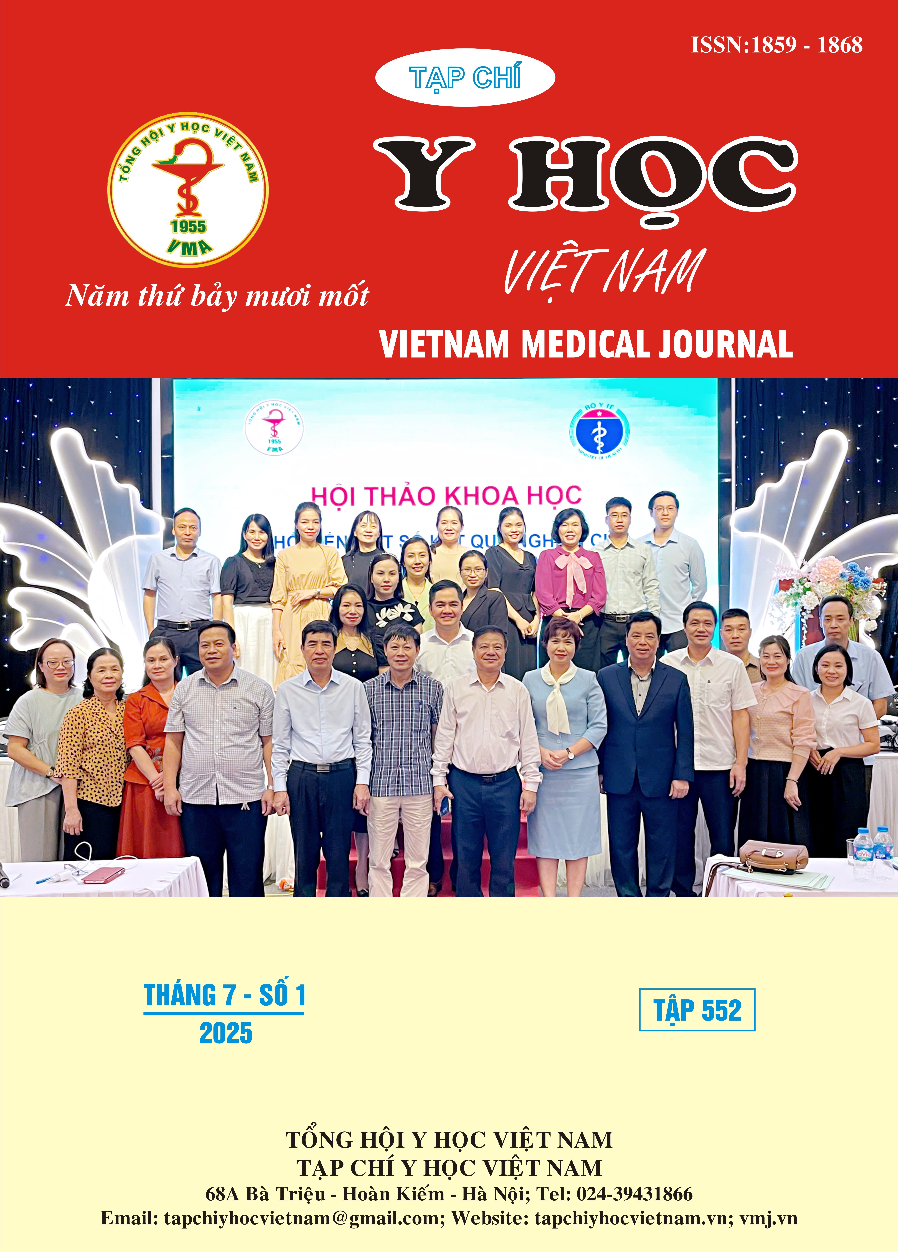ĐẶC ĐIỂM LÂM SÀNG, CẬN LÂM SÀNG VIÊM DA CƠ TRẺ EM TẠI BỆNH VIỆN NHI TRUNG ƯƠNG 2010-2022
Nội dung chính của bài viết
Tóm tắt
Mục tiêu: Mô tả đặc điểm lâm sàng và cận lâm sàng của bệnh nhân viêm da cơ trẻ em tại Bệnh viện Nhi Trung ương. Phương pháp: Nghiên cứu mô tả hồi cứu trên 50 bệnh nhi được chẩn đoán viêm da cơ tại Khoa Miễn dịch-Dị ứng-Khớp, Bệnh viện Nhi Trung ương từ năm 2010 đến 2022. Dữ liệu về đặc điểm lâm sàng, cận lâm sàng và mức độ nặng của bệnh được thu thập và phân tích bằng phần mềm SPSS 22.0. Kết quả: Tuổi trung bình lúc chẩn đoán là 6,5 ± 2,9 tuổi, với tỷ lệ nữ/nam là 1,7:1. Thời gian trung bình từ khi khởi phát triệu chứng đến khi chẩn đoán là 5,5 ± 6,9 tháng. Triệu chứng toàn thân phổ biến nhất là mệt mỏi (78%). Tổn thương da đặc hiệu bao gồm sẩn/ban Gottron (64%), ban heliotrope (40%) và giãn mao mạch quanh móng tay (62%). Yếu cơ được ghi nhận ở 98% bệnh nhân, chủ yếu ở cơ gốc chi (98%), cơ vùng đai chậu (80%) và cơ vùng vai (72%). Đánh giá theo thang điểm MMT8, 90,9% bệnh nhân có yếu cơ nặng (điểm MMT8 ≤ 63), 9,1% có yếu cơ mức độ trung bình (MMT8 từ 64–71). Biểu hiện tiêu hóa gặp ở 36% bệnh nhân, trong đó khó nuốt chiếm 24%. Tổn thương phổi (6%) và tim mạch (2%) ít gặp. Kết luận: Viêm da cơ trẻ em tại Việt Nam có các biểu hiện điển hình về da và cơ, trong đó phần lớn bệnh nhân có mức độ yếu cơ nặng. Tổn thương hệ thống ít gặp hơn. Việc chẩn đoán sớm và điều trị kịp thời có ý nghĩa quan trọng trong cải thiện tiên lượng bệnh.
Chi tiết bài viết
Từ khóa
Viêm da cơ trẻ em, viêm cơ tự miễn, sẩn Gottron, ban heliotrope, MMT8
Tài liệu tham khảo
2. Nguyễn Thị Oanh (2011). Nghiên cứu sử dụng cyclophosphamid phối hợp với methylprednisolon điều trị viêm da cơ có tổn thương phổi kẽ. Luận văn tốt nghiệp Thạc sĩ Y khoa, Đại học Y Hà Nội.
3. Nguyễn Thị Phương Thủy (2015). Nghiên cứu đặc điểm lâm sàng, cận lâm sàng và một số thay đổi miễn dịch trong bệnh viêm đa cơ và viêm da cơ. Luận văn tốt nghiệp Tiến sĩ Y khoa, Đại học Y Hà Nội.
4. Nguyễn Ngọc Chìu (2006). Đặc điểm lâm sàng và xét nghiệm của bệnh viêm da cơ điều trị tại khoa Dị ứng miễn dịch lâm sàng Bệnh viện Bạch Mai 1998-2005. Luận văn tốt nghiệp Bác sĩ đa khoa, Đại học Y Hà Nội.
5. Đặng Quốc Hương (2009). Nghiên cứu các tổn thương phổi ở bệnh nhân viêm da cơ. Luận văn Thạc sĩ Y khoa, Đại học Y Hà Nội.
6. Spencer C.H., Rouster-Stevens K., Gewanter H., et al. (2017). Biologic therapies for refractory juvenile dermatomyositis: five years of experience of the Childhood Arthritis and Rheumatology Research Alliance in North America. Pediatr Rheumatol Online J, 15(1), 50.
7. Aggarwal R., Bandos A., Reed A.M., et al. (2014). Predictors of Clinical Improvement in Rituximab-Treated Refractory Adult and Juvenile Dermatomyositis and Adult Polymyositis. Arthritis Rheumatol, 66(3), 740–749.
8. Oddis C.V., Reed A.M., Aggarwal R., et al. (2013). Rituximab in the Treatment of Refractory Adult and Juvenile Dermatomyositis and Adult Polymyositis: A Randomized, Placebo-phase Trial. Arthritis Rheum, 65(2), 314–324.
9. Wienke J., Deakin C.T., Wedderburn L.R., et al. (2018). Systemic and Tissue Inflammation in Juvenile Dermatomyositis: From Pathogenesis to the Quest for Monitoring Tools. Front Immunol, 9.


